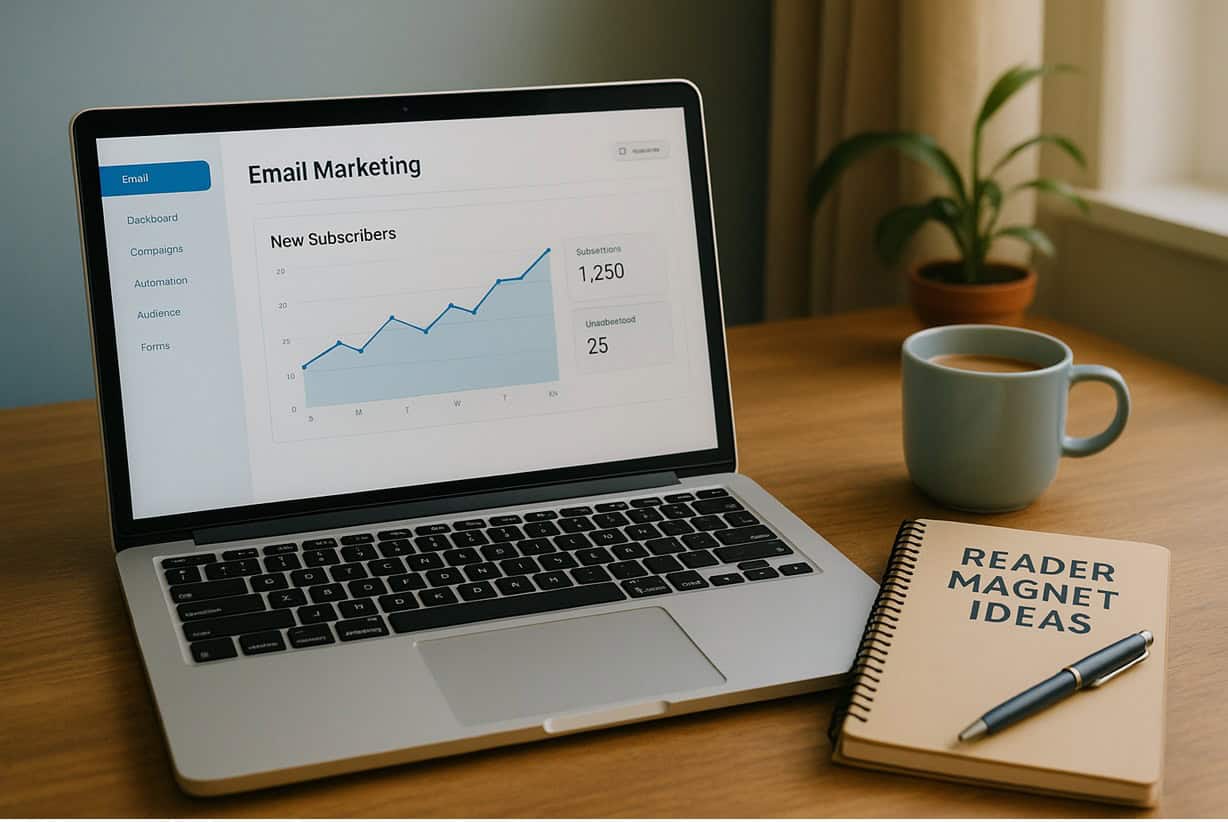How to Build Your Email List as a New Indie Author
“Don’t build your empire on borrowed land. An email list is your direct connection to the readers who matter most.” — Tim Grahl, Your First 1000 Copies
Learn how to attract loyal readers, grow your audience, and boost book sales, starting from zero, with smart, simple email list-building strategies for indie authors.
Every successful indie author has one secret weapon: a reader email list.
Unlike the transient nature of social media platforms, your email list is a powerful tool that you truly own and control. It’s a direct line to your readers, giving you complete control with no algorithms, no ad spend, and no middlemen.
But how do you build a list when you’re starting from scratch?
In part of our series on self-publishing basics, we’ll look at how to attract subscribers, engage them authentically, and turn your list into one of your most powerful book marketing tools. Whether you’re launching your first novel or building your author brand, it all starts here.
Step 1: Why an Email List Matters
Social media followers are great, but they don’t guarantee book sales. Email subscribers do. Your list allows you to:
- Announce new releases directly to readers
- Share behind-the-scenes stories and bonus content
- Build a loyal community that grows with your career
- Increase preorders, reviews, and word-of-mouth referrals
Pro Tip: A good rule of thumb: your email list is your most valuable marketing asset. It’s where casual readers become lifelong fans.
Step 2: Choose an Email Service Provider (ESP)
You’ll need an email marketing platform to collect subscribers, send emails, and manage your campaigns.
Top options for new indie authors:
- MailerLite – Simple, affordable, and beginner-friendly. Offers automation and beautiful templates.
- ConvertKit – Built for creators. Great for segmentation and tagging readers by interest or genre.
- Brevo (formerly Sendinblue) – Excellent free plan for small lists with robust analytics.
- Flodesk – Known for its clean, aesthetic email designs and simplicity.
Pro Tip: Start with a free plan until you reach around 1,000 subscribers. Upgrade when you need advanced features like automation or segmenting.
Step 3: Offer a Compelling Reader Magnet
Readers are no longer enticed by generic ‘newsletters’. They need a compelling reason to sign up. This is where the reader magnet comes in. It’s not just a freebie, it’s a valuable sneak peek into your world. If they love your magnet, they’ll be eagerly awaiting your next book.
Your magnet can be:
- A free short story or prequel
- The first few chapters of your novel
- A deleted scene, bonus epilogue, or character diary
- A how-to guide or checklist (for nonfiction authors)
Pro Tip: Host your magnet with BookFunnel or StoryOrigin. They handle delivery and integrate seamlessly with MailerLite and ConvertKit.
Step 4: Create a Landing Page That Converts
Your landing page is where readers exchange their email address for your magnet. Keep it clear, simple, and inviting. Include:
- A bold headline (“Get a Free Short Story Set in the World of [Book Title]”)
- A short paragraph about what they’ll receive
- A bright, visible sign-up button
- An image of your book or cover art
Pro Tip: Most ESPs like MailerLite and ConvertKit include free landing page templates—no website required.
Step 5: Drive Traffic to Your Sign-Up Page
Now it’s time to get eyes on your offer. Here’s where to share your landing page:
- In your eBook back matter (“Want more stories like this? Join my reader list!”)
- On your author website homepage and contact page
- In your social media bios and pinned posts
- During guest blog posts, interviews, or podcasts
- Inside book giveaways or BookFunnel group promotions
Pro Tip: Link your sign-up form in your eBook’s front matter too—some readers join before they finish reading!
Step 6: Welcome New Subscribers the Right Way
First impressions matter. Set up a welcome email sequence (1–3 messages) that:
- Delivers your reader magnet instantly
- Introduces you and your writing style
- Invites readers to reply or connect
Keep it conversational—like you’re writing to a friend. Example:
“Hey [First Name], thanks for joining my reader community! Here’s your free short story, The Lost Key. I wrote it as a bridge between books 1 and 2, and I can’t wait to hear what you think.”
Pro Tip: Include a P.S. with links to your social channels or other books for gentle cross-promotion.
Step 7: Keep Readers Engaged
A list is only valuable if you nurture it. Aim for 1–2 emails per month—enough to stay top of mind without overwhelming subscribers. What to send:
- Updates on your writing progress
- Behind-the-scenes peeks into your author life
- Sneak previews or cover reveals
- Book recommendations or reading lists
- Seasonal messages or giveaways
Pro Tip: Always include a call to action (CTA), such as “Reply and tell me your favorite character!” Engagement boosts deliverability.
Step 8: Grow Beyond Organic Traffic
Once your system works, scale it up. Try these strategies:
- Newsletter swaps with other authors in your genre
- Paid promos through BookFunnel or StoryOrigin
- Facebook or Instagram ads targeting your genre’s readers
- Giveaways—team up with 2–3 authors for cross-promotion
Pro Tip: Test one paid campaign at a time and track sign-ups. The goal isn’t just volume—it’s finding readers who genuinely want your books.
Step 9: Keep Your List Healthy
As your list grows, maintain good email hygiene:
- Remove inactive subscribers every 6–12 months
- Avoid spammy subject lines or overuse of links
- Always include an unsubscribe link (required by law)
- Track open and click-through rates
Pro Tip: A smaller, active list outperforms a big, disengaged one. Focus on quality, not just numbers.
Wrap Up
Building an email list takes time, but it’s one of the smartest investments you can make as an indie author.
When you own your audience, you own your future. You’re not at the mercy of changing algorithms or ad costs—you’re cultivating genuine connections with the people who love your work.
Start small. Offer value. Show up consistently.
Before long, your reader list will become the foundation of your author career—and one of your favorite ways to connect with fans.
Checklist: Build Your Email List as a New Indie Author
- Choose your email service provider (MailerLite, ConvertKit, etc.)
- Create a compelling reader magnet
- Build a clean, simple landing page
- Add sign-up links to your eBook, website, and social media
- Set up an automated welcome email
- Send engaging content 1–2 times per month
- Promote through swaps, ads, and giveaways
- Clean your list regularly
- Track open and click rates
We trust you’ve found this writer’s guide both enlightening and inspirational. They’re designed to equip you with the tools and insights to bolster your success as a burgeoning author.
The path of writing is one filled with ceaseless learning and enhancement. You are not expected to tread this path solo. We’re thrilled to accompany you on this journey, offering support and motivation at every turn. Our objective is to deliver foundational knowledge and pragmatic guidance, enabling you to traverse the literary landscape with amplified confidence.
For more guidance, see other writer’s guides in the series, such as Amazon KDP Made Easy—7 Steps for Self-Publishing. You might also like Engaging AI-Generated Content: 6 Secrets.
How can we help? To let us know, please fill out our Contact form. Happy writing!
If you have a draft you want to publish with the help of AI, read, Is Your Book Ready to Self-Publish? Lastly, for help writing a non-fiction book, read Write Your First Non-Fiction eBook: a 30-Day Workbook for Getting It Done


